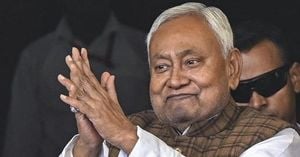In a significant move to bolster ties with Central Asia, US President Donald Trump is set to host the leaders of Kazakhstan, Kyrgyzstan, Tajikistan, Turkmenistan, and Uzbekistan in Washington on Thursday, November 6, 2025, marking the first time all five Central Asian presidents have convened together in the US capital. The summit, which falls on the tenth anniversary of the C5+1 diplomatic format, signals a renewed American commitment to a region long courted by competing global powers.
The gathering comes at a pivotal moment. Since Russia’s invasion of Ukraine in 2022, the geopolitical landscape in Central Asia has shifted dramatically. Moscow’s traditional grip on the region has loosened, prompting the five former Soviet republics to diversify their diplomatic and economic relationships. According to BSS, the leaders have recently held separate summits with Russia’s Vladimir Putin and China’s Xi Jinping, underscoring the intense competition for influence among the world’s major players.
US Secretary of State Marco Rubio, speaking at a State Department reception on Wednesday, November 5, emphasized the alignment of interests between the United States and Central Asia, especially in the development of the region’s vast natural resources. “You are looking to take the resources … that God has blessed your nations with, and turn them into responsible development that allow you to diversify your economies,” Rubio remarked, as reported by Reuters. He also announced his intention to visit all five Central Asian countries in the coming year, signaling a hands-on approach to deepening ties.
The summit’s agenda is expected to focus heavily on rare earth minerals and other critical resources. Central Asia, often described as resource-rich but underexploited, has become a focal point for countries seeking to reduce dependence on Chinese supplies. Kazakhstan is the world’s leading uranium producer, Uzbekistan boasts massive gold reserves, and Turkmenistan is flush with natural gas. Even mountainous Kyrgyzstan and Tajikistan are opening up new mineral deposits, making the region a veritable treasure trove for outside investors.
Yet, tapping into these riches is no easy feat. The five countries are landlocked, collectively about the size of the European Union but home to only 75 million people. Harsh climates, remote mountain ranges, and sprawling deserts complicate logistics. As BSS notes, Central Asia has long been a crossroads of commerce—the Silk Road ran through these lands for centuries—but today, it is hemmed in by Russia to the north, China to the east, and Iran and Afghanistan to the south, all of which have complicated relationships with the West.
Despite these obstacles, efforts to improve connectivity are bearing fruit. Between 2021 and 2024, transport of goods via a new route across the Caspian Sea, which bypasses Russia and links Central Asia with Europe through the Caucasus, soared by 660 percent, according to official statistics. Both Beijing and Brussels have supported this transport corridor, seeing it as a way to break Moscow’s stranglehold on regional trade.
The United States is not alone in its courtship. The European Union has intensified its diplomatic outreach, with EU chief Ursula von der Leyen visiting the region for summits with Central Asian leaders earlier this year. Turkey, leveraging its cultural ties, has expanded military and trade partnerships, especially as Russia’s attention turns inward. China, meanwhile, remains a dominant commercial force, investing billions in infrastructure and presenting itself as the region’s main economic partner.
Deputy Secretary of State Christopher Landau and US Ambassador Sergio Gor recently visited Kazakhstan and Uzbekistan to lay the groundwork for agreements expected to be unveiled during the summit. Landau described the region’s “amazing business opportunities” and stressed the potential for new partnerships. “Many ways to partner there,” he said, according to Reuters.
Senator James Risch, a Republican, used the occasion to announce that he would introduce legislation to repeal the Jackson–Vanik trade rules, a Cold War-era set of restrictions that still limit US trade with non-market economies. If passed, the move could further open the door for American investment in Central Asia, a prospect welcomed by leaders eager to diversify away from Russian and Chinese dominance.
But while economic cooperation is high on the agenda, human rights advocates have raised concerns about the summit’s priorities. Human Rights Watch, in a statement issued Monday, urged the United States to ensure that civil liberties are not sidelined in the rush for business deals. “The summit is taking place while all participating governments have increased efforts to stifle dissent, silence the media, and retaliate against critics at home and abroad,” the organization warned, highlighting the region’s poor press freedom rankings and the recent dismantling of US-backed Radio Free Europe in Central Asia.
Indeed, Turkmenistan ranks near the bottom of the Reporters Without Borders press freedom index, and both Kazakhstan and Kyrgyzstan have faced criticism for curtailing independent media. The region’s authoritarian governments have opened up to tourism and foreign investment, but rights groups caution that civil society remains under threat. As BSS reports, the United States has historically prioritized security and economic interests over democracy promotion in its dealings with Central Asia, a trend that appears likely to continue under Trump’s administration.
Environmental challenges add another layer of complexity. Central Asia is one of the world’s most polluted regions and is especially vulnerable to the effects of climate change. All five countries struggle with water scarcity, a problem exacerbated by rising temperatures and outdated Soviet-era infrastructure. Addressing these issues will require not only investment but also regional cooperation—something the C5+1 format is designed to foster.
The C5+1, established in 2015, serves as the main platform for collective engagement between the United States and the five Central Asian republics. The Washington summit marks the tenth anniversary of this format and comes just two years after the inaugural US-Central Asia summit in 2023. Since the outbreak of the Ukraine war, the frequency and intensity of C5+1 interactions have increased, reflecting the region’s desire to balance relations among multiple powers.
For the US, the summit offers a chance to reassert its presence in a strategically vital part of the world, while for Central Asian leaders, it presents an opportunity to showcase unity and attract investment. The stakes are high: whoever wins the race for influence in Central Asia will shape not only the region’s economic future but also the broader balance of power across Eurasia.
As the five presidents gather in Washington, the world will be watching to see whether the United States can translate diplomatic overtures into lasting partnerships—and whether the voices of civil society will be heard amid the clamor for resources and investment.




